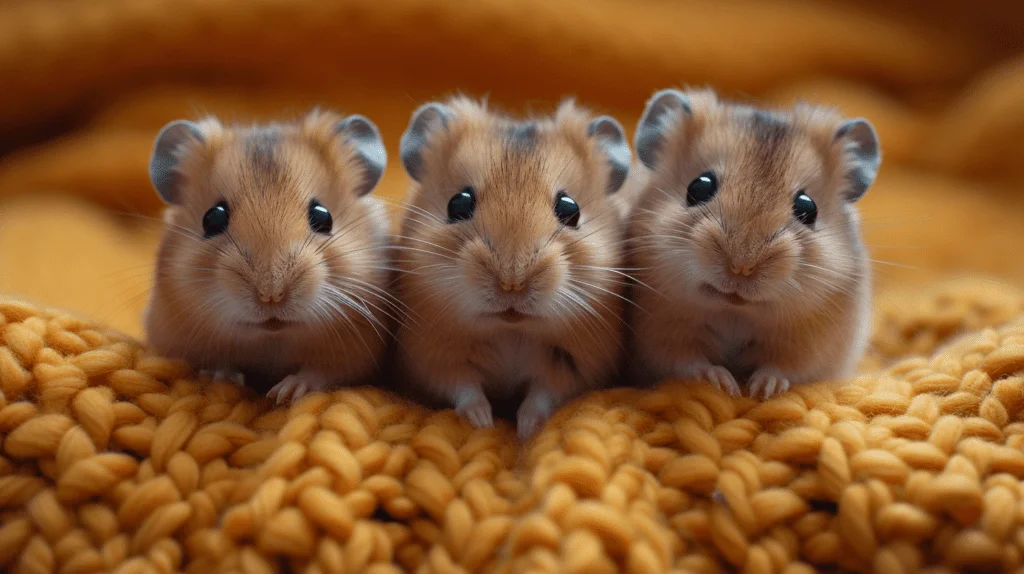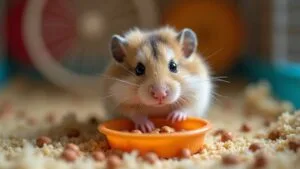
In the kingdom of hamster matchmaking, their powerful olfactory senses play cupid. A female hamster, when she’s in the mood for love, releases a distinct scent. For hamsters, these smells are like Tinder notifications, signaling it’s the perfect moment for romance to bloom.
Before things get serious, hamsters indulge in a playful prelude, almost like a dance routine mapped out by nature itself. This isn’t just random frolicking; it’s a crucial part of their getting-to-know-you phase. Through a mix of chasing and playful interactions, they test the waters, seeing if they’re a good match. To us, it might just look like they’re having fun, but in the world of hamsters, this is their version of serious flirtation.
The soap opera doesn’t end here; depending on whether you’re team Syrian or team Dwarf Hamster, the plot thickens. Syrians, the lone wolves of the hamster world, only seek companionship for procreation. Timing is everything; a female Syrian announces her readiness to mingle only when she’s in heat, which is about every four days. Dwarfs, on the other hand, are more about the communal life, yet, even they follow distinct rules and rituals when it’s time to get their groove on.
Central to this whole operation is the female hamster’s estrous cycle—her natural calendar marking the prime time for potential pregnancy. This period isn’t just about biology; it influences how receptive she is to a partner’s advances, essentially setting the stage for their courtship dance.
If you are thinking about entering the world of hamster breeding, it is crucial to understand the nuances involved. It is not as easy as pairing any male and female hamster together. Instead, you must be mindful of their natural cycles, distinct behaviors, and unique needs. Gaining this knowledge is not only educational but also essential to successfully breed and care for hamsters.
What Are the Signs of Pregnancy in Hamsters?
When hamsters get pregnant, you can spot several signs. These signs help you know what’s happening. Here’s what to look for:
- Nest Building: Pregnant hamsters start to build nests. They gather bedding and other materials. They do this to prepare a safe place for their babies.
- Weight Gain: Like other animals, hamsters gain weight when pregnant. This is because the babies grow inside them.
- Appetite Changes: A pregnant hamster might eat more than usual. This helps her get the energy she needs for her and the babies.
- Increased Aggression: Sometimes, pregnant hamsters get more aggressive. They do this to protect themselves and their future babies.
Early signs of pregnancy can be subtle. But if you notice these changes, it’s likely your hamster is pregnant:
- Changes in behavior. A pregnant hamster might act differently. She might want to be alone more or be more careful.
- Physical changes. Apart from weight gain, you might see her belly get bigger. This is a clear sign that babies are on the way.
How Long Are Hamsters Pregnant For?
Hamsters don’t stay pregnant for long. The time varies a bit between types. Here’s a quick look:
- Syrian hamsters have babies after about 16 to 18 days.
- Dwarf hamsters take around 18 to 22 days.
Knowing the gestation period helps in getting ready for the new pups.
As the birth time gets close, watch for these signs:
- Pre-labor behavior: A hamster may become unsettled and start cleaning herself more than usual.
- Nest building: She will create a cozy nest for her offspring by collecting more bedding and making it soft.
It prepares you to welcome the new pups into the world.

How Can You Care for Pregnant Hamsters?
Taking care of pregnant hamsters is key for their health and their babies. Here are ways to help:
- Give a nutritious diet: Pregnant hamsters need more food. Add protein and fresh veggies to her diet. This keeps her and the babies healthy.
- Make her home safe and comfy: Adjust her cage for safety. Remove high platforms to prevent falls. Add extra bedding for comfort.
- Keep her stress low: Loud sounds and too much handling can stress her. Keep her area quiet. Handle her less often.
- Be careful when touching her: If you need to pick her up, be gentle. Stress can harm her and the babies.
Here are some tips for diet and habitat:
- Diet tips: Add small pieces of boiled egg or chicken for protein. Fresh fruits and vegetables are good, too. But, avoid too much watery food like lettuce. It can cause stomach issues.
- Habitat tips: The cage should be clean and warm. A quiet corner of your home is best. Make sure she has a private spot for her nest.
What Happens After Hamsters Give Birth?
After hamsters give birth, caring for the mother and her pups is crucial. Here’s what to expect and how to help:
- Maternal Instincts Kick-In: The mother hamster will spend a lot of time with her pups. She feeds them, keeps them warm, and moves them around the nest to keep them safe.
- Care for Newborn Pups: For the first few weeks, the babies depend fully on their mom. It’s important not to touch them. This can cause the mother to reject them.
- The Weaning Process: At about 3 to 4 weeks old, the pups start eating solid food. You can introduce tiny bits of fruits and veggies.
- Habitat Adjustments: As the pups grow, make sure their home is safe for exploring. Remove anything they might get stuck in or hurt by.
Here are more tips for this time:
- Don’t disturb the nest: Give the mother space to care for her pups. Too much interference can stress her out.
- Keep the cage clean: But do it carefully. Too much change can upset the mother.
- Food and water: Make sure there’s plenty of food and water. Nursing moms and growing pups eat a lot.
- Separate males and females: By 4 to 5 weeks, it’s time to separate them. This prevents more pregnancies.
Caring for a hamster family is rewarding. It’s also a big responsibility. Knowing what to do helps everyone stay healthy and happy.





